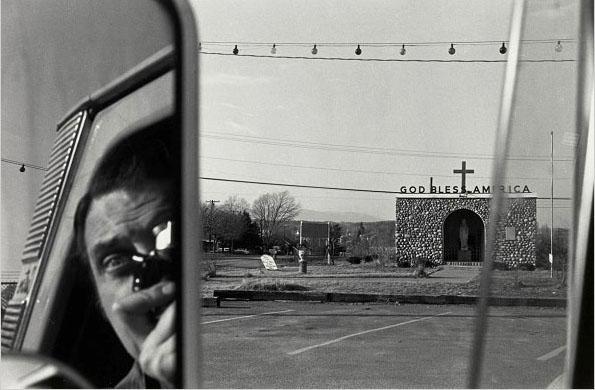Friedlander is famous primarily for his street photography – raw, real, brazen. Lee Friedlander’s photos are like music, and that music is jazz. Through a few notes, previously nonexistent space is built up, beginning to live its own closed and self-sufficient life. In the free improvisation of light spots, the complex music of the city appears in front of the viewer, composed of notes from traffic lights, lampposts, cars, and the faces of random passers-by. And just like in jazz, it is impossible to distinguish a particular melody at first — an arbitrary mix of sounds and musical themes only gradually, as the eye and ear become more experienced, develops into a complex harmonic system with many motives and cross-references. And one suddenly see how harmony and order grow out of intricate complexity, not out of simplicity.
Excessiveness is the word to describe Friedlander’s style, and it goes far beyond photography as a media and street photography as a genre. A clueless composition, people, removed from the back or completely cut off by the frame, a lot of unnecessary elements from the point of view of the frame layout. But they are not in any way “careless” — on the contrary, they are thought out even more carefully than some works with “impeccable composition” — their unpredictability, randomness, fragmentary very accurately reflects the life of a modern city.
In each of Friedland’s works, many different details seem superfluous at first glance, and the composition looks quite stormy. However, on closer inspection, one gets into the real spirit of the streets, some irregularity of real life, unpredictability. Every photo made by him is full of randomness. The viewer has to unravel the visual interweaving of metal grids and dotted lines of wires, wander in a maze of light spots of brightly lit surfaces and deep shadows.
Friedlander manages to catch and capture in the frame an emotion that is not easy to convey. This emotion is the indifference of a big city—the indifference of the vast expanses of America. Friedlander is a restless person: he takes pictures of close friends, usually in a moment of spiritual uplift — they explain something, prove it, doubt it. Around these pulsating islands stretches a neutral abyss. It is clear that for the modern citizen, this state of apathy is the default mode.

This shot belongs to the series of photographs “America by Car”. It is a documentation of a trip to find a modern person. In order to do this, it is necessary to endure kilometers of ugly advertising, deserts, and aggressive landscapes. And even when people do show up, there is no point in leaving the neutral comfort of the car. Friedlander brings us a simple idea: you can photograph anything, but there are very few things worth living for or just taking a step towards — almost none.
The important part of this shot is that it is taken inside of the car, Friedlander does it intentionally. This shot depicts the church, the empty parking lot, wires, trees, the car mirror, and a reflection of the photographer. The mirror of the car cuts the shot into parts and changes the perception of space; it reflects the person with the camera, the face of the photographer looks quite confusing. The emptiness around the church is astonishing, and there is no one out there. Outside of the machine, there is a strange, alien, even frightening world. Behind are a parking lot and a roadside Church with an inscription on the roof: “God bless America.” This self-portrait of Friedlander is one of the hundreds created by the master.